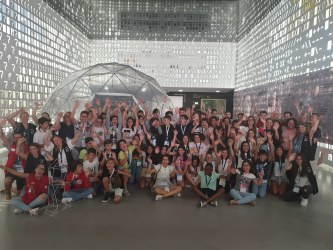75 children, aged from 10 to 14, experienced an adventure that they will never forget: ESERO Portugal gave them the opportunity to actually spend the night at the Pavilion of Knowledge, in a space environment especially built to celebrate the 20th of July 1969, when men first set foot upon the Moon. These lucky kids were assigned the mission of projecting a lunar village, with their own hands, and live a true space mission for one day. They were selected by their own teachers for having already presented space-related projects in their schools.
The departure to this unique space mission in the lobby of the Pavilion of Knowledge took place last Friday, July 19, at 2.30pm. From this time on, these aspiring astronauts and space specialist seekers found themselves overwhelmed with work… and fun. They were divided into 6 teams and each one had to perform a different task, with the common goal to create a lunar base. The teams worked under the supervision of educators from the Pavilion and special guests who joined us from other institutions and companies to help them with their missions. The children had to work hard, because the next morning each team had to present their results and conclusions to parents and friends in an auditorium full of people.
But what were these 6 missions assigned to the teams? Keeping it simple, they were asked to: Plan a 3D Moon shelter, establish radio communications, do physical exercise, understand the concept of “space food” and learn how to prepare it, rescue a Moon rover with technical difficulties, and understand the importance of working together as a team.
The group in charge of the Moon shelters had to use a 3D printer to create a model of a lunar base that included a greenhouse, a power station, a water reservoir and shelters for the other astronauts and staff. All these modules were left printing overnight and were ready when the teams woke up. Another important task was the communication with the ground station, so the designated explorers had to build antennas capable to transmit and receive radio signals, allowing messages to be exchanged between the lunar base and the Earth.
The body of an astronaut requires a high level of physical fitness and it must be trained for the particular conditions of space, especially to be able to support great accelerations and micro gravity. At this lunar camp, these children had to train as if they were astronauts, like they do in the Mission X program. Our young aspiring astronauts also had to find out what they are allowed to eat during a space mission. What kind of food can be sent to space? Is it possible to grow some on the lunar surface? The team in charge with this mission learned how to create terrariums and explored hydroponic methods, for a self-regulating and sustainable ecosystem capable of producing food. They even ended up cooking a midnight snack for their colleagues from the other teams.
Part of the work on the Moon's surface has to be done outside the spaceship. EVA is short for Extra-Vehicular Activity and represents all of these activities. One of the working groups simulated an EVA that “forced” them to rescue a rover that needed to be repaired and to collect lunar soil samples for mineralogical analysis. In the end the team also had to rescue one of the astronauts, who “decided” to faint on the Moon.
Last but not least, the astronauts need to take care of their own minds and even each other while living under these difficult conditions. So, one of the teams had to overcome group tests and be able to choose specific tasks for each one of their members according to their own skills.
Around midnight, all members of the Moon Camp went to rest. Or at least they tried to… Some of them were so excited with all this experience that they only fell asleep a few hours later. On Saturday morning, the 20th, our young space explorers publicly showed the work they have done on "lunar soil" – and anyone who wanted to watch their presentations had to ask for our “astronauts” permission by radio to enter inside the Moon shelter. But the most difficult mission of all for these future Moon explorers will be to return back to Earth…
This initiative was organized by ESERO Portugal with the support of the Faculty of Psychology and the Faculty of Science from the University of Lisbon, an association of amateur radio and a 3D Printer company, among several others.
Ciência Viva, from Lunar Base. Over and Out.




